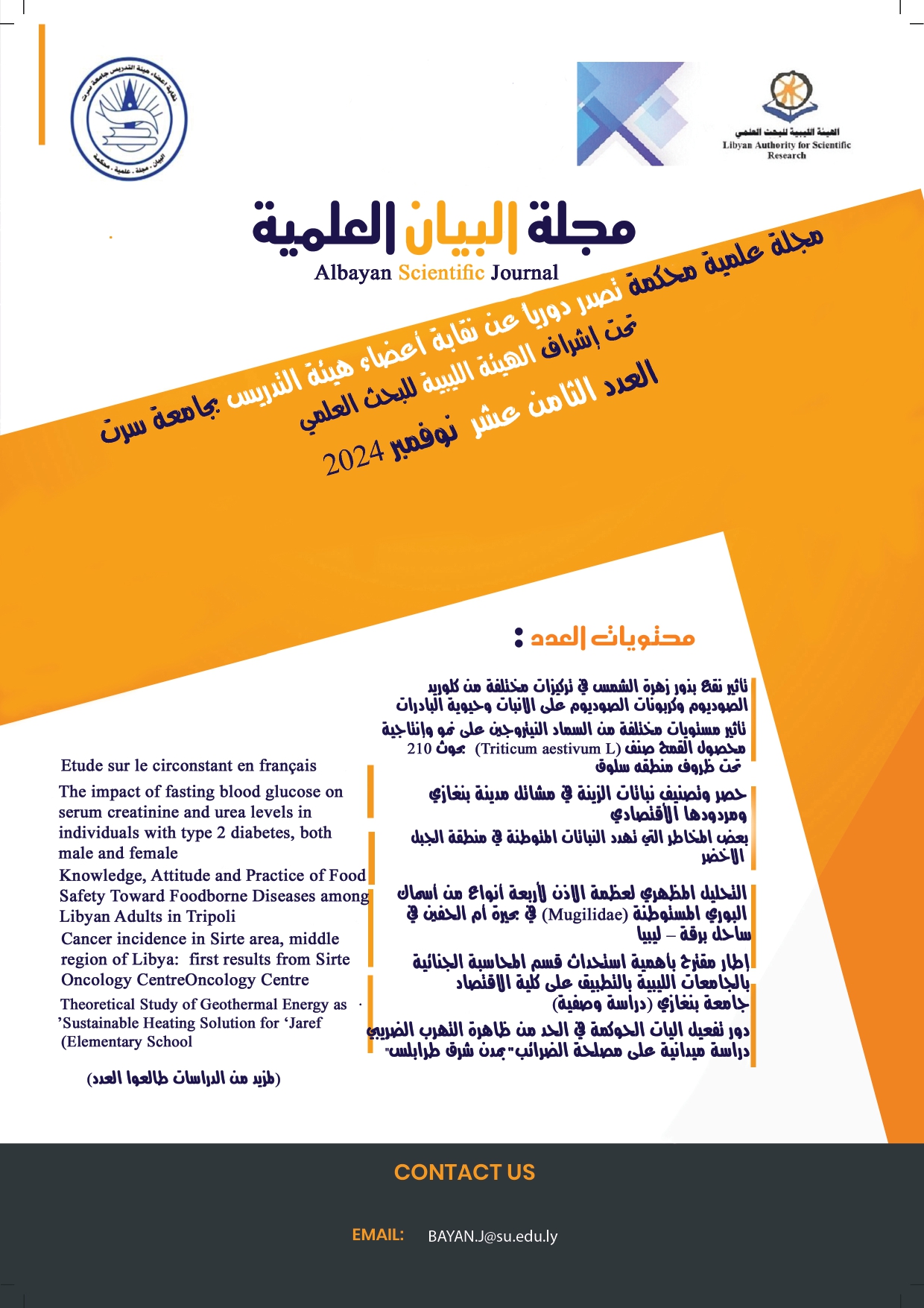تأثير نقع بذور زهرة الشمس في تركيزات مختلفة من كلوريد الصوديوم وكربونات الصوديوم على الانبات وحيوية البادرات
DOI:
https://doi.org/10.37375/bsj.vi18.3010الكلمات المفتاحية:
زهرة الشمس، الملوحة والقلوية، الانبات والنموالملخص
أجريت تجربة معملية في معمل تكنولوجيا الحبوب بقسم المحاصيل – كلية الزراعة – جامعة عمر المختار لدراسة تأثير تراكيز مختلفة من أملاح كلوريد الصوديوم NaCl وكربونات الصوديوم Na2Co3 على إنبات ونمو بذور زهرة الشمس. أجريت التجربة العاملية باستخدام التصميم العشوائي الكامل (RCD) في ثلاث مكررات، حيث كانت المعاملات تركيزات مختلفة من ملح كلوريد الصوديوم ( (NaCl كنترول (ماء مقطر)، 3000 ppm و 5000 ppm) و ملح كربونات الصوديوم Na2Co3) ) كونترول(ماء مقطر)، 3000 ppm و 5000 ppm) على صفات إنبات ونمو بادرات زهرة الشمس (جيزة 102). أظهرت النتائج عدم وجود فروق معنوية بين الأملاح المستخدمة في جميع الصفات المدروسة. وأظهرت النتائج فروقاً معنوية بين تراكيز الأملاح في جميع صفات الإنبات والنمو لبذور زهرة الشمس: نسبة الإنبات (%)، طول الجذر (سم)، طول الساق (سم)، الوزن الرطب للبادرة (جم)، ومعامل قوة الإنبات، حيث أعطت معاملة الشاهد (ماء مقطر) أعلى القيم المسجلة لجميع الصفات المدروسة مقارنة بأقل القيم عند معاملتها بتركيز 5000 ppm. وأظهر التفاعل بين أملاح كلوريد الصوديوم وكربونات الصوديوم وتركيزاتها المختلفة فروقاً معنوية، حيث أعطت معاملة الشاهد (ماء مقطر) أعلى القيم لجميع الصفات المدروسة مقارنة بأقل القيم المسجلة عند معاملتها بالملحين (كلوريد الصوديوم وكربونات الصوديوم) بتركيز 500 ppm.
المراجع
Ali, S.M., Abdulatif. Y. I., & Husnh. S. Y. (2014). Impact of Salinity on Seed Germination and Seedling Characteristics of Sunflower (Helianthus annuus L.) International Journal of Research and Innovations in Earth Science. Vol. 1(2): 2394-13.
Amirinejad, A.-A., Sayyari, M., Ghanbari, F., & Kordi, S. (2017). Salicylic acid
improves salinity-alkalinity tolerance in pepper (Capsicum annuum L.). Adv.
Hort. Sci. 31, 157–163. doi: 10.13128/ahs-21954.
An, Y., Gao, Y., Tong, S., & Liu, B. (2021). Morphological and physiological traits related to the response and adaption of Bolboschoenus planiculmis seedlings grown under salt-alkaline stress conditions. Front. Plant Sci. 12:567782. doi: 10.3389/fpls.2021.567782.
Chen, Y., Li, Y., Sun, P., Chen, G., & Xin, J. (2017). Interactive effects of salt
and alkali stresses on growth, physiological responses, and nutrient (N, P)
removal performance of Ruppia maritima. Ecol. Eng. 104, 177–183.
De Oliveira Filho, J. G., & Egea, M. B. (2021). Sunflower seed byproduct and its fractions for food application: An attempt to improve the sustainability of the oil process. Journal of Food Science, 86(5), 1497-1510.
Gao, Z., Han, J., Mu, C., & Lin, J. (2014). Effects of saline and alkaline stresses on growth and physiological changes in oat (Avena sativa L.) seedlings. Not Bot Horticulture Agronomy botany, 42: 357-362.
Gomez, K.A. & A.A. Gomez. (1984). Statistical Procedures for Agricultural Research. 2nd Edn., John Wiley Sons, New York, USA., ISBN: 978-0-471-87092-0, Pages: 704.
Gupta B.,& Huang B.( 2014). Mechanism of salinity tolerance in plants: Physiological, biochemical, and molecular characterization. International Journal of Genomics, 2014(1), 701596.
Kaiwen, G., Zisong, X., Yuze, H., Qi, S., Yue, W., Yanhui, C., ... & Huihui, Z. (2020). Effects of salt concentration, pH, and their interaction on plant growth, nutrient uptake, and photochemistry of alfalfa (Medicago sativa) leaves. Plant Signal. Behav. , 15(12), 1832373.
Kronzucker H.J., Coskun D., Schulze L.M., Wong J.R.,& Britto D.T. (2013). Sodium as nutrient and toxicant. Plant and Soil, 369, 1–23.
Liu, J., Guo, W.Q., & Shi. D.C., (2010). Seed germination, seedling survival, and physiological response of sunflowers under saline and alkaline conditions. International Journal for Photosynthesis Research. 48 (2): 278-286.
Lu, H., Ziqi, W., Chenyang, X., Luhao, L., & Chunwu, Y., (2021). Multiomics analysis provides insights into alkali stress tolerance of sunflower (Helianthus annuus L.) Plant Physiol Biochem:166:66-77. doi 10.1016/j.plaphy.2021.05.032. Epub 2021 May 29.
Maathuis F.J.M., Ahmad I., & Patishtan J. (2014). Regulation of Na+ fluxes in plants. Frontiers in Plant Science, 2014: 467.
Maiti, R.K., M. de la Rosa-Ibarra & N.D. Sandoval. (1994). Genotypic variability in glossy sorghum lines for resistance to drought, salinity and temperature stress at the seedling stage. J. Plant Physiol., 143: 241-244.
Okon, O.G. (2019). Effect of Salinity on Physiological Processes in Plants. In: Giri, B., Varma, A. (eds) Microorganisms in Saline Environments: Strategies and Functions. Soil Biology, vol 56. Pp.237- 262.Springer, Cham. https://doi.org/10.1007/978-3-030-18975-4_10
Puttha, R., Karthikeyan, V., Sayomphoo, H., Jittimon, W., Thanya, P., Pao. Srean., Kanokporn, P., & Narin, C. (2023). Exploring the Potential of Sunflowers: Agronomy, Applications, and Opportunities within Bio-Circular-Green Economy. Horticulture. 9, 1079. https://doi.org/10.3390/ horticulturae9101079.
Tonmoy, F. M., Halim, M.A., Feroza, H., & Nahid, A. (2018). Effects of sodium chloride on germination and seedling growth of Sunflower (Helianthus annuus L.) Jahangirnagar University J. Biol. Sci. 7(1): 35-44,
Wang, H., Takano, T., & Liu, S. (2018). Screening and evaluation of saline-alkaline tolerant germplasm of rice (Oryza sativa L.) in soda saline-alkali soil. Agronomy
:205. doi: 10.3390/agronomy8100205
Wang, J., Zhang, Y., Yan, X., & Guo, J. (2020). Physiological and transcriptomic
analyses of yellow horn (Xanthoceras sorbifolia) provide important insights
into salt and saline-alkali stress tolerance. PLoS One 15:e0244365. doi: 10.1371/
journal. pone.0244365
Zhang, H., Liu, X.-L., Zhang, R.-X., Yuan, H.-Y., ...& Liang,Z.W (2017). Root damage under alkaline stress is associated with reactive oxygen species accumulation in rice (Oryza sativa L.). Frontiers in Plant Science. 8,1580.














